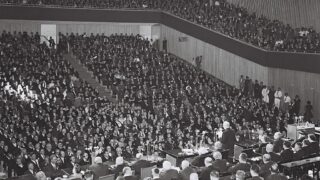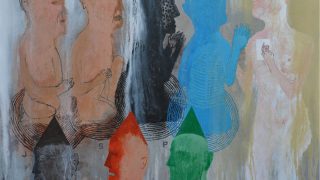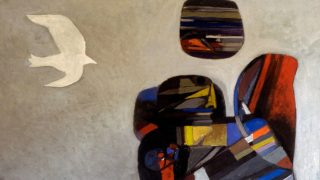I have strong memories of the Palestinian flag going back to my childhood. During the First Intifada, my mother would have us draw the red triangle with its parallel black, white, and green stripes on draft paper. Once the drawings were complete, she would hide them under our beds. “The soldiers can’t find them here,” she warned us, “if they do, they will take you away.” This was our regular afternoon drawing assignment: draw, rejoice, hide, and safely preserve. As we went to bed, we thought of the soldiers as bogeymen, and our flags, we believed, were treasures powerful enough to entice them.
One day, a group of soldiers stormed our neighborhood and demanded to enter our house. My parents were away, leaving my brother, sister, and me to deal with the situation. My brother bravely perched out of the window and told the soldiers that he would not allow them in. Seeing that he was persistent, the soldiers struck our thick metal door with the butt of their M16s, ordering us to be let in. “They know,” I thought to myself, “They know about the flags.” I am not going to lie; the sight of soldiers trying to break into our home terrified me. Something about it, however, also empowered me: four crayons and a piece of paper, I thought, could summon an army jeep to my door. What if I started singing fedayee?
Of course, it was not the drawn flags they were looking for, but this was the story I made up as a child. It is not an implausible story, since the flag was illegal back then. In 1967, the Israeli military governor banned the display of Palestinian national symbols, amongst which the flag figured prominently. The shababs of the Intifada would endanger their lives to hang a flag on an electricity pole, and schools risked closure when its students paraded national symbols. I doubt everybody knew the historical meanings of the four colors that represented the Palestinian cause. We knew, however, that these colors empowered us and threatened them. It was a truly uniting symbol, and this is all we needed to know.
My latest memory of the flag is much less daunting. It was at the security control of Ben Gurion airport in Tel-Aviv (as an East Jerusalemite, I am “allowed” to travel through the Israeli airport with a travel document). In my luggage, I had packed a keffieh my students gave me. It had the Palestinian flag on one side and the logo of Al-Quds University on the other. I had taught at Al-Quds University for two years and was leaving Palestine again. My students gave me the keffieh to remember them, to remember home, and to remember to come back. I could not leave the country without it, so I packed the gift in my bag and headed to the airport.
I reached the security control where my belongings were thoroughly screened. As the security officer searched through my bag, the four colors of the flag slowly emerged. As if by some strange bodily instinct, I was reminded of my mom’s warning. Oh no! I had not hidden it well. What was the officer going to say? What was I to do? My mind was racing. The officer, however, barely noticed the keffieh or the colors that adorned it. He seemed more interested in the color of my underwear than that of my flag. The mix of emotions, memory, and confusion left me wondering. My mere existence as a Palestinian warrants unimaginable security checks, but my flag barely gets noticed. I am demographic and security threat, but the symbol of my people is not.
I ponder these paradoxes as the General Assembly of the United Nations votes in favor of flying the Palestinian flag at the UN headquarters in New York. The Oslo Accords gave us the right to put our national symbols on display without offering us the very thing these symbols were meant to symbolize. We did not rid ourselves of a colonial occupation, nor did we achieve unity amongst Palestinians—neither inside nor outside historical Palestine. We did not get the political sovereignty we were promised, and justice for our people was still non-existent. Our symbols have become a golden cage designed to tame our hopes so that we can rejoice in the illusion of independence. Printed on passports, stamps, and school textbooks, they conjured tricks capable of turning a political cause into a magic show. And so I ask you: which flag would you want to wave? The flag of an illusionary statehood, or the flag my mother taught me how to draw? The flag that goes unnoticed by the Israeli soldier, or the one that makes him angrily bang on your door?







